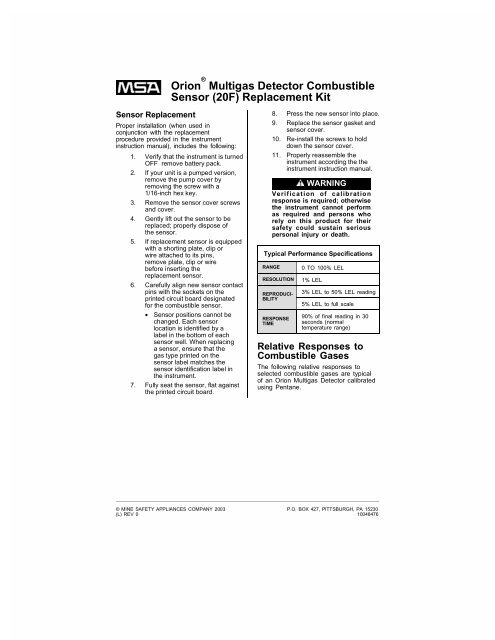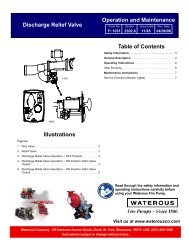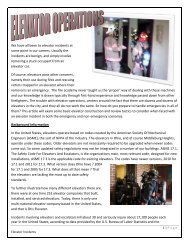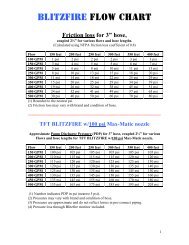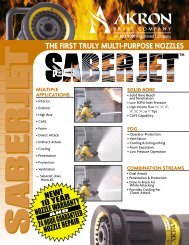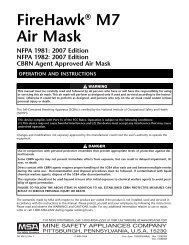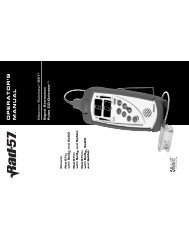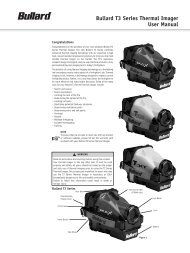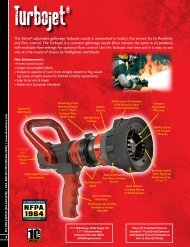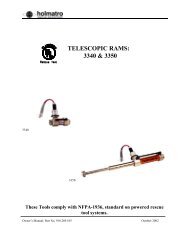Orion Multigas Detector Combustible Sensor (20F) Replacement Kit ...
Orion Multigas Detector Combustible Sensor (20F) Replacement Kit ...
Orion Multigas Detector Combustible Sensor (20F) Replacement Kit ...
You also want an ePaper? Increase the reach of your titles
YUMPU automatically turns print PDFs into web optimized ePapers that Google loves.
<strong>Orion</strong> ® <strong>Multigas</strong> <strong>Detector</strong> <strong>Combustible</strong><br />
<strong>Sensor</strong> (<strong>20F</strong>) <strong>Replacement</strong> <strong>Kit</strong><br />
<strong>Sensor</strong> <strong>Replacement</strong><br />
Proper installation (when used in<br />
conjunction with the replacement<br />
procedure provided in the instrument<br />
instruction manual), includes the following:<br />
1. Verify that the instrument is turned<br />
OFF remove battery pack.<br />
2. If your unit is a pumped version,<br />
remove the pump cover by<br />
removing the screw with a<br />
1/16-inch hex key.<br />
3. Remove the sensor cover screws<br />
and cover.<br />
4. Gently lift out the sensor to be<br />
replaced; properly dispose of<br />
the sensor.<br />
5. If replacement sensor is equipped<br />
with a shorting plate, clip or<br />
wire attached to its pins,<br />
remove plate, clip or wire<br />
before inserting the<br />
replacement sensor.<br />
6. Carefully align new sensor contact<br />
pins with the sockets on the<br />
printed circuit board designated<br />
for the combustible sensor.<br />
• <strong>Sensor</strong> positions cannot be<br />
changed. Each sensor<br />
location is identified by a<br />
label in the bottom of each<br />
sensor well. When replacing<br />
a sensor, ensure that the<br />
gas type printed on the<br />
sensor label matches the<br />
sensor identification label in<br />
the instrument.<br />
7. Fully seat the sensor, flat against<br />
the printed circuit board.<br />
8. Press the new sensor into place.<br />
9. Replace the sensor gasket and<br />
sensor cover.<br />
10. Re-install the screws to hold<br />
down the sensor cover.<br />
11. Properly reassemble the<br />
instrument according the the<br />
instrument instruction manual.<br />
º WARNING<br />
Verification of calibration<br />
response is required; otherwise<br />
the instrument cannot perform<br />
as required and persons who<br />
rely on this product for their<br />
safety could sustain serious<br />
personal injury or death.<br />
Typical Performance Specifications<br />
RANGE<br />
RESOLUTION<br />
REPRODUCI-<br />
BILITY<br />
RESPONSE<br />
TIME<br />
0 TO 100% LEL<br />
1% LEL<br />
3% LEL to 50% LEL reading<br />
5% LEL to full scale<br />
90% of final reading in 30<br />
seconds (normal<br />
temperature range)<br />
Relative Responses to<br />
<strong>Combustible</strong> Gases<br />
The following relative responses to<br />
selected combustible gases are typical<br />
of an <strong>Orion</strong> <strong>Multigas</strong> <strong>Detector</strong> calibrated<br />
using Pentane.<br />
© MINE SAFETY APPLIANCES COMPANY 2003 P.O. BOX 427, PITTSBURGH, PA 15230<br />
(L) REV 0 10048476
COMBUSTIBLE GAS<br />
MULTIPLY<br />
%LEL READING<br />
BY<br />
COMBUSTIBLE GAS<br />
MULTIPLY<br />
%LEL READING<br />
BY<br />
Acetone 1.1<br />
Acetylene 0.7<br />
Acrylonitrile 1 0.8<br />
Benzene 1.1<br />
Butane 1.0<br />
1,3 Butadiene 0.9<br />
n-Butanol 1.8<br />
Carbon Disulfide 1 2.2<br />
Cyclohexane 1.1<br />
2,2 Dimethylbutane 1.2<br />
2,3 Dimethylpentane 1.2<br />
Ethane 0.7<br />
Ethyl Acetate 1.2<br />
Ethyl Alcohol 0.8<br />
Ethylene 0.7<br />
Formaldehyde 2 0.5<br />
Gasoline (unleaded) 1.3<br />
Heptane 1.1<br />
Hydrogen 0.6<br />
n-Hexane 1.3<br />
Isobutane 0.9<br />
Isobutyl Acetate 1.5<br />
Isopropyl Alcohol 1.1<br />
Methane 0.5<br />
Methanol 0.6<br />
Methyl Isobutyl ketone 1.1<br />
Methylcyclohexane 1.1<br />
Methyl Ethyl Ketone 1.1<br />
Methyl Tertiary Butyl Ether 1.0<br />
Mineral Spirits 1.1<br />
iso-Octane 1.1<br />
n-Pentane 1.0<br />
Propane 0.8<br />
Propylene 0.8<br />
Styrene 2 1.9<br />
Tetrahydrofuran 0.9<br />
Toluene 1.1<br />
Vinyl Acetate 0.9<br />
VM&P Naptha 1.6<br />
0-Xylene 1.2<br />
Response Notes:<br />
1. The compounds may reduce the sensitivity<br />
of the combustible gas sensor by poisoning<br />
or inhibiting the catalytic action.<br />
2. These compounds may reduce the<br />
sensitivity of the combustible gas sensor<br />
by polymerizing on the catalytic surface.<br />
3. For an instrument calibrated on Pentane,<br />
multiply the displayed %LEL value by the<br />
conversion factor above to get the true %LEL.<br />
4. These conversion factors should be used<br />
only if the combustible gas is known.<br />
5. These conversion factors are typical for a<br />
<strong>Orion</strong> <strong>Multigas</strong> <strong>Detector</strong>. Individual<br />
units may vary by + 25% from these values.<br />
© MINE SAFETY APPLIANCES COMPANY 2003 P.O. BOX 427, PITTSBURGH, PA 15230<br />
(L) REV 0 10048476


